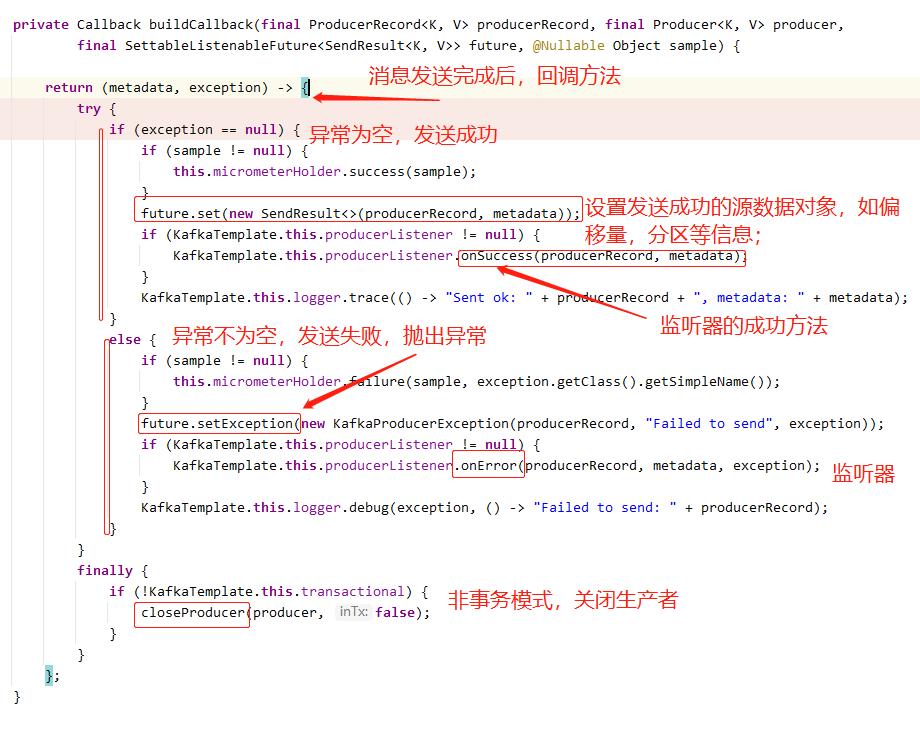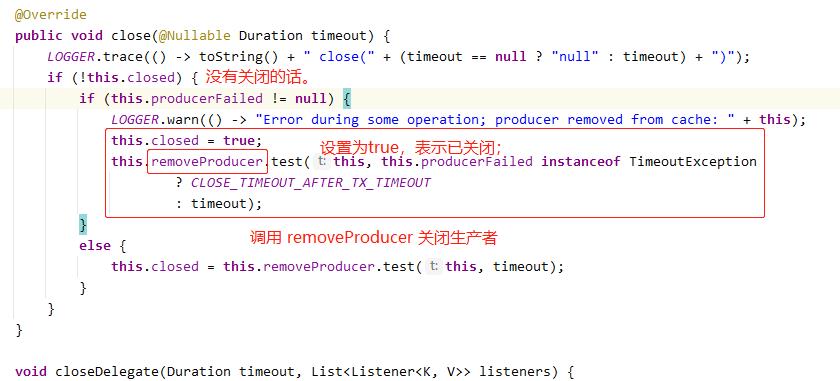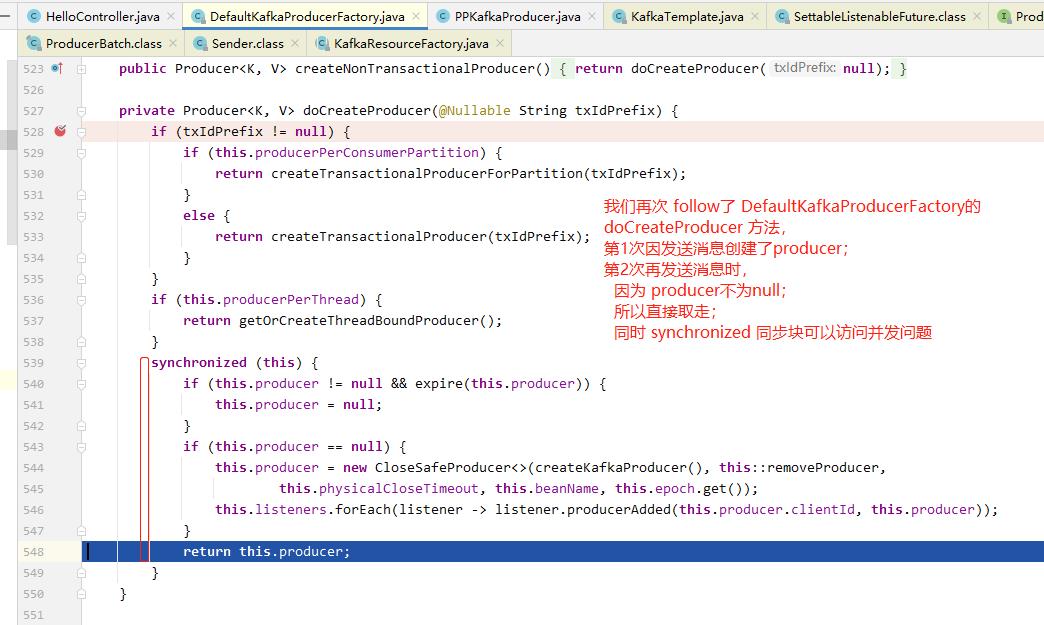spring-kafka整合:KafkaTemplate-kafka模板类介绍
Posted PacosonSWJTU
tags:
篇首语:本文由小常识网(cha138.com)小编为大家整理,主要介绍了spring-kafka整合:KafkaTemplate-kafka模板类介绍相关的知识,希望对你有一定的参考价值。
【README】
1,本文主要关注 KafkaTemplate的重点方法,并非全部方法;
2,KafkaTemplate 底层依赖于 DefaultKafkaProducerFactory , 关于 DefaultKafkaProducerFactory 的介绍,refer2
【1】KafkaTemplate 类说明
用于执行高级操作的模板。 当与 DefaultKafkaProducerFactory 一起使用时,模板是线程安全的。 生产者工厂和 org.apache.kafka.clients.producer.KafkaProducer 确保这一点;
public class KafkaTemplate<K, V> implements KafkaOperations<K, V>, ApplicationContextAware, BeanNameAware,
ApplicationListener<ContextStoppedEvent>, DisposableBean {【1.1】构造方法
使用提供的生产者工厂和 autoFlush 设置创建一个实例。
如果您已将生产者的 linger.ms 配置为非默认值并希望立即在此模板上发送操作,无论该设置如何, 又或者您希望阻塞直到服务器根据acs属性确认已收到消息, 需要把autoFlush设置为true。如果 configOverrides 不为 null 或不为空,则将使用合并的生产者属性创建一个新的 DefaultKafkaProducerFactory,这些属性在提供的工厂属性之后进行覆盖。
public KafkaTemplate(ProducerFactory<K, V> producerFactory, boolean autoFlush,
@Nullable Map<String, Object> configOverrides) {
Assert.notNull(producerFactory, "'producerFactory' cannot be null");
this.autoFlush = autoFlush;
this.micrometerEnabled = KafkaUtils.MICROMETER_PRESENT;
// 是否自定义生产者工厂
this.customProducerFactory = configOverrides != null && configOverrides.size() > 0;
if (this.customProducerFactory) {
Map<String, Object> configs = new HashMap<>(producerFactory.getConfigurationProperties());
// 覆盖工厂属性
configs.putAll(configOverrides);
// 创建新的 DefaultKafkaProducerFactory
DefaultKafkaProducerFactory<K, V> newFactory = new DefaultKafkaProducerFactory<>(configs, producerFactory.getKeySerializerSupplier(), producerFactory.getValueSerializerSupplier());
// 设置物理关闭生产者的超时时间
newFactory.setPhysicalCloseTimeout((int) producerFactory.getPhysicalCloseTimeout().getSeconds());
// 设置是否分区
newFactory.setProducerPerConsumerPartition(
producerFactory.isProducerPerConsumerPartition());
// 设置是否 每个线程创建一个 生产者;
newFactory.setProducerPerThread(producerFactory.isProducerPerThread());
// 新工厂赋值
this.producerFactory = newFactory;
} else {
this.producerFactory = producerFactory;
}
// 是否开启kafka事务
this.transactional = this.producerFactory.transactionCapable();
}【1.2】发送消息方法(非常重要)
发送消息有很多方法,大致分为两类;
- send();
- doSend();
【1.2.1】send() 发送消息
有4个外观方法,使用的都是默认topic;
@Override
public ListenableFuture<SendResult<K, V>> sendDefault(@Nullable V data) {
return send(this.defaultTopic, data);
}
@Override
public ListenableFuture<SendResult<K, V>> sendDefault(K key, @Nullable V data) {
return send(this.defaultTopic, key, data);
}
@Override
public ListenableFuture<SendResult<K, V>> sendDefault(Integer partition, K key, @Nullable V data) {
return send(this.defaultTopic, partition, key, data);
}
@Override
public ListenableFuture<SendResult<K, V>> sendDefault(Integer partition, Long timestamp, K key, @Nullable V data) {
return send(this.defaultTopic, partition, timestamp, key, data);
}
@Override
public ListenableFuture<SendResult<K, V>> send(String topic, K key, @Nullable V data) {
ProducerRecord<K, V> producerRecord = new ProducerRecord<>(topic, key, data);
return doSend(producerRecord);
}
可以看到,最后还是调用了 底层的 doSend() 方法;
【1.2.2】doSend() 方法
5个 doSend() 方法的外观方法 ,这5个方法对 topic ,分区, 消息key,时间戳,消息value 进行了重载
@Override
public ListenableFuture<SendResult<K, V>> send(String topic, @Nullable V data) {
ProducerRecord<K, V> producerRecord = new ProducerRecord<>(topic, data);
return doSend(producerRecord);
}
@Override
public ListenableFuture<SendResult<K, V>> send(String topic, K key, @Nullable V data) {
ProducerRecord<K, V> producerRecord = new ProducerRecord<>(topic, key, data);
return doSend(producerRecord);
}
@Override
public ListenableFuture<SendResult<K, V>> send(String topic, Integer partition, K key, @Nullable V data) {
ProducerRecord<K, V> producerRecord = new ProducerRecord<>(topic, partition, key, data);
return doSend(producerRecord);
}
@Override
public ListenableFuture<SendResult<K, V>> send(String topic, Integer partition, Long timestamp, K key,
@Nullable V data) {
ProducerRecord<K, V> producerRecord = new ProducerRecord<>(topic, partition, timestamp, key, data);
return doSend(producerRecord);
}
@Override
public ListenableFuture<SendResult<K, V>> send(ProducerRecord<K, V> record) {
Assert.notNull(record, "'record' cannot be null");
return doSend(record);
}底层 doSend() 定义如下:
protected ListenableFuture<SendResult<K, V>>
doSend(final ProducerRecord<K, V> producerRecord)
protected ListenableFuture<SendResult<K, V>> doSend(final ProducerRecord<K, V> producerRecord) {
// 获取生产者
final Producer<K, V> producer = getTheProducer(producerRecord.topic());
this.logger.trace(() -> "Sending: " + producerRecord);
final SettableListenableFuture<SendResult<K, V>> future = new SettableListenableFuture<>();
Object sample = null;
if (this.micrometerEnabled && this.micrometerHolder == null) {
this.micrometerHolder = obtainMicrometerHolder();
}
if (this.micrometerHolder != null) {
sample = this.micrometerHolder.start();
}
// 发送消息
Future<RecordMetadata> sendFuture =
producer.send(producerRecord, buildCallback(producerRecord, producer, future, sample));
// May be an immediate failure (注意,这里可能马上失败,或有运行时异常抛出)
if (sendFuture.isDone()) {
try {
sendFuture.get(); // 这里调用get会阻塞,如果发送没有完成的话
}
catch (InterruptedException e) {
Thread.currentThread().interrupt();
throw new KafkaException("Interrupted", e);
}
catch (ExecutionException e) {
throw new KafkaException("Send failed", e.getCause()); // NOSONAR, stack trace
}
}
if (this.autoFlush) { // 自动刷新
flush();
}
this.logger.trace(() -> "Sent: " + producerRecord);
return future;
}【代码解说】
step1, 调用了 getTheProducer() 获取生产者 ;

关于 DefaultKafkaProducerFactory.createProducer() 可以参见 以下博文,因篇幅,本文不再赘述;
spring-kafka整合:DefaultKafkaProducerFactory默认kafka生产者工厂介绍_PacosonSWJTU的博客-CSDN博客
step2,producer.send(producerRecord, buildCallback(producerRecord, producer, future, sample)) ; 调用了 buildCallback(...) 构建回调对象;


非事务模式,则关闭生产者;
由 DefaultKafkaProducerFactory 可知, 生产者是 CloseSafeProducer, 其包裹了 原生 kafka生产者; 所以 调用了 CloseSafeProducer.close() 方法;


step3,自动刷新缓存 flush();
如果 ProducerFactory 提供单例生产者(例如 DefaultKafkaProducerFactory),则调用此方法才有意义。
public void flush() {
Producer<K, V> producer = getTheProducer();
try {
producer.flush();
}
finally {
closeProducer(producer, inTransaction());
}
}
protected void closeProducer(Producer<K, V> producer, boolean inTx) {
if (!inTx) { // 非事务才关闭
producer.close(this.closeTimeout);
}
}【2】KafkaTemplate 发送消息与生产者复用

我们再次 follow了 DefaultKafkaProducerFactory的 doCreateProducer() 方法;
第1次因为发送消息 新建了 producer;
第2次再发送消息时,因为producer 不为null;所以直接取走;
同时 synchronized同步块可以避免并发问题;
发送消息后,是否关闭生产者,可以参考 【小结】
【小结】
通过分析 KafkaTemplate.doSend() 消息发送分发, 我们可以看到,
每发送一条消息,如果抛出异常的话,则会关闭kafka生产者,否则不会关闭生产者;原因参见
以上是关于spring-kafka整合:KafkaTemplate-kafka模板类介绍的主要内容,如果未能解决你的问题,请参考以下文章
 https://blog.csdn.net/PacosonSWJTU/article/details/121306370
https://blog.csdn.net/PacosonSWJTU/article/details/121306370 https://blog.csdn.net/PacosonSWJTU/article/details/121306370
https://blog.csdn.net/PacosonSWJTU/article/details/121306370